Sorry to be a bit late this week, particularly since, as it happens, we won’t have a column next week, due to some scheduling issues. See you on June 8th!
MIND MGMT (Dark Horse, $3.99)
by D.S. Randlett
A perennial discussion in the world of letters is the one concerning the difference between “genre” and “literary” fiction, and the merits of each. The dividing lines in the arguments on any side that people choose to take in that debate are blurry and ever-changing, as you basically have an argument over matters of taste. But there is a difference between the two words, “genre” and “literary,” but to me they seem to impart information about the flavor of works rather than their inherent merits. The difference arises from two sources: one is how an artist chooses to present the work, the other how the reader chooses to accept it. We typically walk in to literary fiction expecting something great, something that will move us, while we expect genre to present us with a fun yarn and maybe some imaginative ideas. Of course, one of the great thrills of genre is the surprise, not at a plot twist, but that you’ve found nourishment from an unexpected source.
In comics, the lines are blurrier still, to the point that there is no distinction. This is what makes comics, despite the frustrations of the marketplace, one of the most thrilling media for storytelling. Comics are a medium, a culture, where books like A Contract With God and Watchmen share the same well-deserved caché, not because of what they they are like merely aesthetically, but because of what they have to say.
Matt Kindt’s MIND MGMT is only one issue in, and it’s hard to put it up there with the greats. We don’t really know any of the story quite yet (it is a mystery, after all), but Kindt’s ambition is immediately apparent. But his ambition here isn’t to be more than the genre that he’s choosing to explore. He’s not looking to upend expectations of paranormal mystery or espionage stories, just to do that kind of story exceedingly well. Kindt’s grasp of character is what elevates the story, such as it is at this moment.
The facts of the plot as presented in this issue are pretty thin and intentionally vague. There’s a journalist named Maru, struggling a few years after writing a nonfiction bestseller, who’s trying to get to the bottom of the mystery of an entire flight of people who have been stricken with amnesia. There also appear to be psychics. And Spies. What makes this book so good, though, is that Kindt is really deft at finding the humanity in these situations. There’s a scene where everyone on the aforementioned flight comes to realize that they’ve forgotten who they are, and the sense of confusion and fear that Kindt gets across is palpable. Also, Kindt does a great job of putting you in Meru’s head as she begins her journey. There’s a great scene where Meru is conducting field interviews, and each interviewee reminds Meru of something from her life, and it really sells just why Meru finds this mystery so compelling.
MIND MGMT is the best of genre storytelling, but it also contains the elegant touch of the literary. I can’t recommend it enough.
Rating: 




Out of a Possible 5 Stars
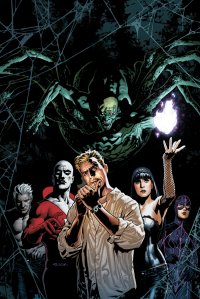 JUSTICE LEAGUE DARK #9 (DC Comics, $2.99)
JUSTICE LEAGUE DARK #9 (DC Comics, $2.99)
By Devon Sanders (@devonsanders)
Nearly 10 months into DC Comics’ relaunch of their entire comics line, I’ve finally been given a reason to believe. Don’t get me wrong; I’ve enjoyed some books. Batman’s been phenomenal. Wonder Woman’s been great but the books that held my attention hardest were the ones not afraid to take advantage of the past while building a new direction. None did this better than Animal Man writer Jeff Lemire. His version’s breathed new life into one of comics’ more odd characters while setting a course that could have huge consequences for the entire DC Universe.
One of the titles I anticipated most was Justice League Dark, a title featuring mostly Vertigo universe mainstays John Constantine and Shade, The Changing Man along with Zatanna, Deadman and Madame Xanadu fighting dark things within the DC Universe. It should’ve been great but what it was just… it was there. No exploration of new storytelling possibilities. Just Constantine sort of bristling at stuff and a one-time look of him standing next to Superman.
Now, Lemire; he gets it. he gets how much trouble having a John Constantine within The DC Universe should be. Add a centuries old vampire with a newfound taste for magic (I, Vampire) and a government controlled controled shapeshifter (Black Orchid) who answers only to a double-dipping Justice League liaison Steve Trevor and you have a Justice League Dark #9 that makes a DC Comics fan want to take a second look.
The Dark League has broken up and scattered across the globe. Col. Steve Trevor enters a room filled with empty bourbon bottles and cigarettes that have served their purpose. Wherever there are empties and crushed out cigarettes, you’ll find find a John Constantine, Hellblazer. Felix Faust, one of The Justice League’s oldest threats is in search of an ancient artifact of great power and The Justice League Dark with their special skills sets, are far better suited for the job than a Green Lantern ever could be. With the artifact secured, Justice League Dark find themselves in possession of a map that will lead them to a book containing the secrets of all magic.
Writer Jeff Lemire gets the awesomeness of finding new from the old within the New 52. Lemire delights in exploration and it shows in every word. What’s not to love in a universe where Constantine can square off against a Felix Faust or get smacked by Batman? With this issue’s ending, I found more to root and hope for than I’ve seen in most DC Comics. Could a DC rebirth of a certain bespectacled British magic-wielding teen be far behind?
Artist Mikel Janin has improved a lot from his first issue. His characters are less posed and stiff and learned to help the writer tell the story.
Under Jeff Lemire, this book could be the title it should be. Justice League Dark #9 is a fun and intriguing look at the possibilities lying in the dark.
Rating: 




Out of a Possible 5 Stars
Clockwork Watch: The Arrival (available from Clockworkwatch.com; not sure of the price, as I received a pdf to review)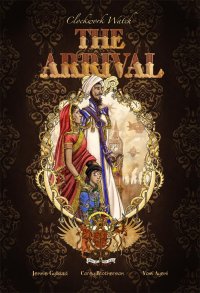
By Jeb D.
Last Halloween, my sister in law, inspired by the film Steamboy, decided to go steampunk for Halloween. We hit one of the big national party-store chains, and she approached a saleswoman, hesitant as to just how to explain what she was looking for. “Umm… have you ever heard of ‘steampunk;?” The woman led us around a corner to an enormous rack of mass-produced goggles, bowlers, gloves, dusters… with “Steampunk” stamped with a trademark notice on each package. And this may not be news to you, but it was to me: steampunk is now a commodity, and using it more or less obligates a creator to offer a perspective unique enough to keep us reading.
Clockwork Watch is intended to be an “immersive,” multi-media experience, that will extend to online role-play, live theatre, video, street markets, and doubtless any other media that “transmedia producer and digital strategist” Yomi Ayeni, creator of the concept, can dream up. This comic is the first installment of what will be three graphic novels tied into the “retro-Futurist” version of England in which the overall story will be set. Ayeni’s concept has been adapted into a comics story by writer Corey Brotherson and artist Jennie Gyllblad.
Our guide into this world is Janay, a young boy from a version of India that bears some resemblance to the colonial subcontinent of Kipling’s days, but is clearly a more egalitarian place, as Janay’s father, Chan, is a highly educated scientist, who has moved his family to London to pursue his research. While his family lives in good society, and Chan travels in exalted circles, both Janay and his mother are unhappy; even in this more forward-thinking London than a real Janay might have known, they’re made aware of the fact that they’re “different”, though ironically, that’s actually what Janay most wants: to escape the rigid structure that his father dictates for his life, and to find his own place in this world of mechanical marvels—none greater than the “clockwork man,” whom he names Ashwin, given to him as a servant. When a misunderstanding, born of prejudice and ignorance, lands Janay in trouble, it’s Ashwin who will stand in for his family, accompanying Janay on the start of what appears to be a vintage young boy’s adventure.
Though she doesn’t skimp on background detail and “cool-looking” machines and such, Gyllblad’s style doesn’t get caught up in the pseudo-science trappings of the environment, focusing instead on character, evoking the water-colors of a classic children’s book. In the backmatter, Brotherson takes the reader through the exhaustive process he used to shape Ayeni’s media-spanning concept into a script suitable for graphic adaptation, and (without having seen the original source material), I’d have to say he’s done a commendable job, as the story moves briskly through its sequence of events, bringing us up to speed on the ins and outs of this world, and this society, without dawdling for info-dump. The characterization is sometimes sketchy (would the boys who taunt Janay really be completely blasé about seeing his clockwork man come to life? Or are they just there to provide some conflict?), but generally effective: Janay’s mother, in particular, is more “liberated” than an Indian woman would have been in the historical Raj, but in just a few words and gestures, she shows us how she must still keep her strength hidden in a man’s world.
Hard to say how, or if, Clockwork Watch, as a multimedia concept, will catch on, but the comics version is starting off with vivid characters, in an intriguing setting, and with the promise of visually interesting adventures to come: that’s a recommendation right there, no matter what else does, or does not, materialize.
Rating: 




Out of a Possible 5 Stars
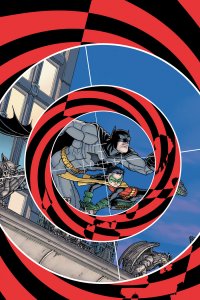 Batman Incorporated #1 (DC, $2.99)
Batman Incorporated #1 (DC, $2.99) By Adam Prosser
<Troy McClure>
CONTINUITY! Is there any word more thrilling to the human soul?
</Troy McClure>
Well yes, though the actual importance of continuity shouldn’t be minimized. In this era in which continuity seems like nothing but a lead weight around the neck of superhero comics, it’s important to remember just how thrilling it was when the Marvel bullpen (it’s always those guys, isn’t it?) introduced the idea that events, beyond obvious stuff like the introductions of new characters and elements into a storyline, could impact later stories. I’d argue continuity is probably the single main aspect of superhero comics that turned them from a diversion for kids to an obsession for “geeks”—in fact, it may be the thing that single-handedly created the “geek” subculture.
But of course, everything has its downside, and boy howdy, has that downside ever started to outstrip the virtues when it comes to continuity. I’ve written before about how modern reboots seem to be aimed more at the obsessive nerds who keep track of continuity than they are at gaining a new audience, and that’s been particularly true in the case of the New 52, with their “soft reboot”. DC tried to have their cake and eat it too by rebooting all their books, but in an incredibly haphazard fashion that kept the continuity of their most popular books, Green Lantern and Batman, supposedly intact, despite what an utter trainwreck this made of the internal logic of their universe. And while a number of good comics were sacrificed on the altar of the New 52, it seems like even a book like Batman, Inc., which is now continuing after a hiatus, has been irreparably broken by the relaunch.
Because the fact of the matter is, this is a book in which Batman, in the new continuity, has been fighting crime for something like 5 years…and yet has a 10-year-old son with Talia Al Ghul.
But hey, I wasn’t paying that much attention to the New 52 at this point anyway, and it sure looks like Grant Morrison isn’t, either, aside from Batman’s costume being reconfigured. The Batman, Inc. story relies very specifically on pre-existing continuity, both the story Morrison’s been telling for several years now across multiple bat-books, and the larger, extended story of Batman that’s been unfolding in DC comics since the 30s, so this book becomes the poster boy for the idea that you should ignore cross-company continuity and just focus on the story that interests you. This is, I think, one of the points Morrison’s been trying to make in his DC work for a while now, and Final Crisis actually reads quite a bit better if you read it as a story of how the DC Universe finally gave up on consistency and narrative logic across multiple titles.
Once you’ve processed this, it’s amazing how easy it is to simply pick up the thread of the previous Batman, Inc. and all that came before it, and continue onwards. Bruce Wayne is back in Gotham as Batman, apparently putting his globe-trotting recruitment drive on hold and fighting alongside his son Damien as Robin. Except that the multinational, multitendrilled evil organization known as Leviathan is busy putting down roots in Gotham as well, and they’ve put out a hit on Damien. By the end of the issue, the hit has apparently been carried out by a surprisingly pathetic new assassin-supervillain who goes by the name Goatboy (yes, explicitly named for the Bill Hicks routine). And no, I’m not sure what the presence of an apparently “real” goat-man who’s killed in a slaughterhouse moments before Damien proclaims he’s now a vegetarian—Morrison’s animal-rights activism once again surfacing in his superhero work—has to do with anything.
Other than this hiccup, Batman, Inc. seems to be back on track. As I wrote about the latest issue of Action Comics, it seems more and more like Morrison is detaching himself from DC’s editorial mandates and corporate policies, trying to find his own path and stick to it while ignoring any attempt to fit in. The ship may be sinking all around him, but Morrison’s band plays on.
Rating: 




Out of a Possible 5 Stars
Youngblood #71 (Image/Extreme, $2.99)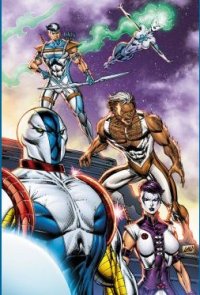
by D.S. Randlett
The Extreme Studios relaunch has been a rather interesting thing to watch. The rather strange exercise came out of the gate really strong with two series that are still quite good : Prophet and Glory. Those two series promised intelligent resurrections of not so intelligent ideas, and it made me interested in seeing how the other titles in the line would be handled. Unfortunately, those two offerings appear to be outliers rather than harbingers for the potential of the Extreme relaunch.
Of course, only one of the relaunched titles can boast Rob Liefeld’s direct involvement: Youngblood, so it wasn’t to be expected that this series was going to upend expectations. Liefeld does quite a bit of the art here, with some assists from “up and comer” John Malin. The book features all of your favorite Liefeldian perversions of anatomy. The women are a little bit too slender while having a cup size that would give Arnold in his lifting days a hernia, men’s arms are a little bit too huge, feet just look plain weird if Liefeld hasn’t found something to hide them behind. The greatest hits are all here!
McLaughlin’s script is actually pretty clever in spots, and his ideas actually come pretty close to working. The story concerns the titular superteam, and obvious squad of X-Men/Teen Titans ripoffs. The team’s Y sigil is a pretty obvious tip off on that score, as if everything else weren’t apparent enough. McLaughlin makes the decision to make none of these characters likable in the least, and I can’t help but feel that this is a conscious decision on his part. And really, I kind of wanted that idea to work, for this to be the Curb Your Enthusiasm of superhero books.
Youngblood is pretty obviously playing for comedy, but it’s held back by a need to fulfill all of the stereotypes of nineties Image. McLaughlin tries to wring laughs out of his dialog, but it has the off-putting effect of someone trying way too hard to get you to like them. Youngblood knows that you already hate it, and it almost rides that to different territory for a superhero book. But then, Youngblood wants to be liked, and any chance it had to be different goes out the window once it makes that desire apparent.
Liefeld has his fans, and they’ll probably like this book. But for the rest of us, it’s like Bob Dylan’s Christmas album without any of the confidence to go completely crazy (like this), and yeah, without any of the past glories. Youngblood could have been something deliriously loopy, but it makes the mistake of caring what you think.
Rating: 




Out of a Possible 5 Stars
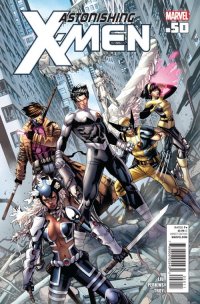 Astonishing X-Men #50 (Marvel, $3.99)
Astonishing X-Men #50 (Marvel, $3.99)
By Jeb D.
I like Mike Perkins’ artwork quite a bit, but I’ve never thought that the X-Men were particularly suited to his talents (or do I meant that the other way around?) And he’s been given the task this month of handling the biggest mainstream-media X-Men event since the release of the X-Men: First Class film, as Northstar pops the question to his male lover, Kyle Jinadu.
Now, this wouldn’t be an X-Men story (well, any story really) if there weren’t obstacles to this union that go beyond societal acceptance: Kyle has his unspoken reasons for declining the proposal, laying seeds for a mystery to be solved; all well and good.
None of which explains the look that Perkins has slapped on Kyle’s face, as Northstar extends the engagement ring, and Kyle’s expression suggests that he’s just been handed a pile of excrement, or maybe a poisonous scorpion. I know, I know: X-books area always about big emotions, the melodramatic perils of romance, the idea of living day-to-day as life-and-death. But for heaven’s sake: Kyle’s face has just become the amusing/ironic avatar for hipster comics guys on a hundred message boards, and I kinda doubt that was the intention.
Is the comic any good? Well, writer Marjorie Liu steals a base by bringing in the Black Widow, a character she writes as well as anyone, for some expository convo with Wolverine, so that’s a good thing. But that’s only one of several similarly static sequences in which we’re peppered with more backstory and explanation than ought to be necessary in a series that operates theoretically outside the strict confines of monthly X continuity. There’s the requisite flying and punchups for those in the cheap seats, but I don’t get the sense that Liu is balancing the relationship stuff with the splode stuff as well as she has in past outings (so to speak). Anyway, the real thing happens next issue, so you might as well wait for that one; you can hunt down the .jpg of Kyle’s reaction shot to keep you amused in the meantime.
Rating: 




Out of a Possible 5 Stars